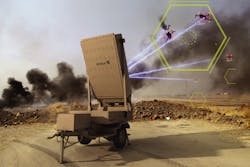Air Force asks industry to model and simulate electromagnetic warfare effects that destroy electronics
KIRTLAND AIR FORCE BASE, N.M. – U.S. Air Force high-energy weapons experts are reaching out to industry to find companies able to model and simulate the effects of electromagnetic warfare weapons intended to destroy or disable enemy electronics, improvised explosive devices, unmanned aircraft, and similar systems.
Officials of the Air Force Research Laboratory Directed Energy Directorate at Kirtland Air Force Base, N.M., issued a broad agency announcement (FA9451-22-S-0001) on Monday for the High Power Electromagnetics (HPEM) Modeling and Effects project.
High-power microwaves offer technologies that enable low-collateral-damage military applications, counter electronic effects, counter improvised explosive devices, and counter weapons of mass destruction. Focused beams of microwave energy can protect aircraft and ships against incoming missiles, and to help attack electronic targets. Researchers are developing sophisticated compact devices that convert stored electrical energy into high-power bursts able to penetrate structures and destroy electronics.This potential $80 million project seeks to characterize the effectiveness of potential HPEM weapons by developing tools and generating vulnerability data to feed those tools.
The HPEM Modeling and Effects project consists of several future calls on specific areas of interest, which will be issued over the next five years.
The vulnerability data consists of the likelihood of destruction or disruption of enemy electronics when subjected to high-power electromagnetic energy. The project also investigates how to predict and model the fundamental mechanisms that cause these disruptions or failures.
Related: The new era of high-power electromagnetic weapons
Companies interested should monitor SAM.gov online at https://www.sam.gov/content/homefor contracting opportunities under the HPEM Modeling and Effects program. The HPEM Modeling and Effects projects encompasses 14 technical in two broad areas: effects and numerical simulation.
Effects will involve empirical effects testing; HPEM weapons effectiveness modelling; fundamental HPEM effects research; battle damage assessment and recuperation time; emerging technologies like HPEM sources, diagnostics, and sensors; and evaluation tools for effects databases.
Numerical simulation involves vii. developing simulation codes for HPEM systems and components modeling; using codes in developing HPEM systems and components; developing simplified high-performance computing and analysis tools; digital engineering of HPEM systems and components; multi-scale materials modelling; developing HPEM engagement-level codes; engagement and mission level modeling of HPEM systems; and validating all software.
Air Force researchers say they expect to award one contract for each call.
Email technical questions to [email protected]. Email business questions to Adan Dominguez at [email protected], or Julian Landavazo at [email protected].
More information is online at https://sam.gov/opp/48dcad42f0d443bf90992a062d435060/view.

John Keller | Editor-in-Chief
John Keller is the Editor-in-Chief, Military & Aerospace Electronics Magazine--provides extensive coverage and analysis of enabling electronics and optoelectronic technologies in military, space and commercial aviation applications. John has been a member of the Military & Aerospace Electronics staff since 1989 and chief editor since 1995.

